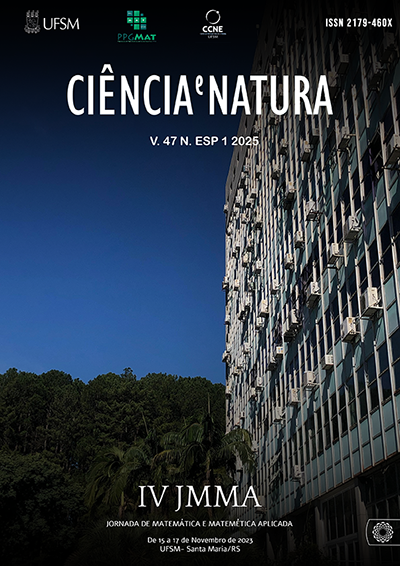Um modelo do tipo SIR baseado em agentes para múltiplas populações
DOI:
https://doi.org/10.5902/2179460X89848Palavras-chave:
SIR saturado, Multiplas populações, Transmissão de doenças, PrevisõesResumo
Neste artigo, investigamos o impacto da propagação epidêmica em um modelo do tipo SIR com saturação entre múltiplas populações em interação. O modelo é derivado de um limite médio que considera múltiplos agentes. A análise teórica confirma a boa colocação do modelo, indicando que ele possui uma solução única que depende continuamente das condições iniciais e parâmetros. Além disso, realizamos simulações numéricas para um cenário envolvendo duas cepas circulantes, onde também exploramos o cenário em que a doença sofre mutação durante a transmissão, levando ao aumento da transmissibilidade. Uma comparação entre a dinâmica do modelo SIR com e sem saturação revela que a saturação resulta em uma dinâmica mais branda da doença.
Downloads
Referências
Abbey, H. (1952). An examination of the reed-frost theory of epidemics. Hum. Biol., 24(3):201–233.
Allen, L. J. S. (2007). An introduction to Mathematical Biology. Pearson Prentice Hall.
Ascher, U. & Greif, C. (2011). A First Course in Numerical Methods. (1st ed). SIAM. DOI: https://doi.org/10.1137/1.9780898719987
Dhaoui, I., Van Bortel, W., Arsevska, E., Hautefeuille, C., Alonso, S. T., & Kleef, E. (2022). Mathematical modelling of covid-19: a systematic review and quality assessment in the early epidemic response phase. International Journal of Infectious Diseases, 116:S110. DOI: https://doi.org/10.1016/j.ijid.2021.12.260
Hethcote, H. W. (2000). The mathematics of infectious diseases. SIAM Review, 42(4):599–653. DOI: https://doi.org/10.1137/S0036144500371907
Kermack, W. & Mckendrick, A. (1927). A contribution to the mathematical theory of epidemics. The Royal Socity, 115(772):700–721. DOI: https://doi.org/10.1098/rspa.1927.0118
Kolokolnikov, T. & Iron, D. (2021). Law of mass action and saturation in sir model with application to coronavirus modelling. Infectious Disease Modelling, 6(1):91–97. DOI: https://doi.org/10.1016/j.idm.2020.11.002
Kutter, J. S., Spronken, M. I., Fraaij, P. L., Fouchier, R. A., & Herfst, S. (2018). Transmission routes of respiratory viruses among humans. Current Opinion in Virology, 28:142–151. DOI: https://doi.org/10.1016/j.coviro.2018.01.001
Lazo, M. J. & De Cezaro, A. (2021). Why can we observe a plateau even in an out of control epidemic outbreak? a seir model with the interaction of n distinct populations for covid-19 in brazil. Trends in Computational and Applied Mathematics, 22(1):109–123. DOI: https://doi.org/10.5540/tcam.2021.022.01.00109
Marques, J. C., De Cezaro, A., & Lazo, M. J. (2022). A sir model with spatially distributed multiple populations interactions for disease dissemination. Trends in Computational and Applied Mathematics, 23(1):143–154.
Marques, J. C., De Cezaro, A., & Lazo, M. J. (2023). On an emerging plateau in a multi-population sir model. preprint, 23(1):1–21. DOI: https://doi.org/10.5540/tcam.2022.023.01.00143
Maurmann, A. C., Travessini De Cezaro, F., & Cezaro, A. (2023). A fractional sirc model for the spread of diseases in two interacting populations. Latin-American Journal of Computing, 10(2):46–57.
Mistro, D. C. & Rodrigues, L. A. D. (2021). Impacto do distanciamento social em um modelo discreto para covid-19. Ciˆencia e Natura, 43(Ed. Esp.):e12. DOI: https://doi.org/10.5902/2179460X66996
Silva, M. I., Marques, J. C., Conza, A. O., De Cezaro, A., & Gomes, A. C. F. N. (2023). The stiffness phenomena for the epidemiological sir model: a numerical approach. Latin-American Journal of Computing, 10(2):32–45.
Sotomayor, J. (1979). Lic¸ ˜oes de Equac¸ ˜oes Diferenciais Ordin´arias. (11th vol). Instituto de Matem´atica Pura e Aplicada, CNPq.
Techl, G. (2012). Ordinary Differential Equations and Dynamical Systems. (140th vol, Graduate Studies in Mathematics). AMS. DOI: https://doi.org/10.1090/gsm/140
Downloads
Publicado
Como Citar
Edição
Seção
Licença
Copyright (c) 2025 Ciência e Natura

Este trabalho está licenciado sob uma licença Creative Commons Attribution-NonCommercial-ShareAlike 4.0 International License.
Para acessar a DECLARAÇÃO DE ORIGINALIDADE E EXCLUSIVIDADE E CESSÃO DE DIREITOS AUTORAIS clique aqui.
Diretrizes Éticas para Publicação de Revistas
A revista Ciência e Natura está empenhada em garantir a ética na publicação e na qualidade dos artigos.
A conformidade com padrões de comportamento ético é, portanto, esperada de todas as partes envolvidas: Autores, Editores e Revisores.
Em particular,
Autores: Os Autores devem apresentar uma discussão objetiva sobre a importância do trabalho de pesquisa, bem como detalhes e referências suficientes para permitir que outros reproduzam as experiências. Declarações fraudulentas ou intencionalmente incorretas constituem comportamento antiético e são inaceitáveis. Artigos de Revisão também devem ser objetivos, abrangentes e relatos precisos do estado da arte. Os Autores devem assegurar que seu trabalho é uma obra totalmente original, e se o trabalho e / ou palavras de outros têm sido utilizadas, isso tem sido devidamente reconhecido. O plágio em todas as suas formas constitui um comportamento publicitário não ético e é inaceitável. Submeter o mesmo manuscrito a mais de um jornal simultaneamente constitui um comportamento publicitário não ético e é inaceitável. Os Autores não devem submeter artigos que descrevam essencialmente a mesma pesquisa a mais de uma revista. O Autor correspondente deve garantir que haja um consenso total de todos os Co-autores na aprovação da versão final do artigo e sua submissão para publicação.
Editores: Os Editores devem avaliar manuscritos exclusivamente com base no seu mérito acadêmico. Um Editor não deve usar informações não publicadas na própria pesquisa do Editor sem o consentimento expresso por escrito do Autor. Os Editores devem tomar medidas de resposta razoável quando tiverem sido apresentadas queixas éticas relativas a um manuscrito submetido ou publicado.
Revisores: Todos os manuscritos recebidos para revisão devem ser tratados como documentos confidenciais. As informações ou ideias privilegiadas obtidas através da análise por pares devem ser mantidas confidenciais e não utilizadas para vantagens pessoais. As revisões devem ser conduzidas objetivamente e as observações devem ser formuladas claramente com argumentos de apoio, de modo que os Autores possam usá-los para melhorar o artigo. Qualquer Revisor selecionado que se sinta desqualificado para rever a pesquisa relatada em um manuscrito ou sabe que sua rápida revisão será impossível deve notificar o Editor e desculpar-se do processo de revisão. Os Revisores não devem considerar manuscritos nos quais tenham conflitos de interesse resultantes de relacionamentos ou conexões competitivas, colaborativas ou outras conexões com qualquer dos autores, empresas ou instituições conectadas aos documentos.






